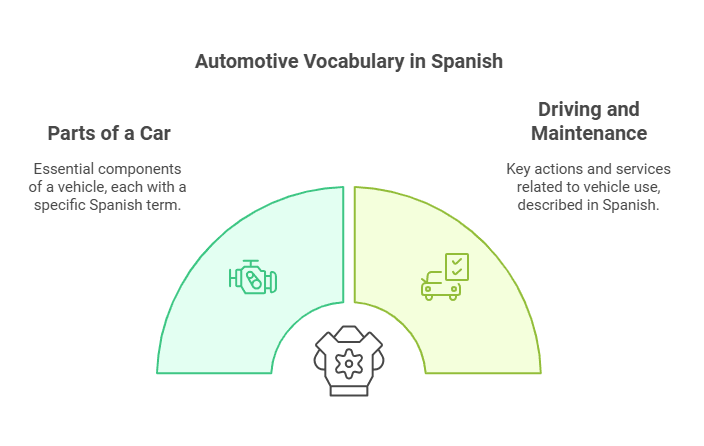Spanish for Automobile: 10 Common Terms Made Simple
Introduction
Learning Spanish for automobile-related terms is essential for travelers, car enthusiasts, and professionals working in the automotive industry. Whether you’re renting a car in Spain, buying a vehicle in Latin America, or simply expanding your vocabulary, understanding how to say “automobile” in Spanish and other related terms can make your experience smoother and more enjoyable. In this article, we’ll explore the translation of “automobile” in Spanish, delve into common automotive terms, and provide practical tips for using them effectively.
What Is the Spanish Word for Automobile?
The word “automobile” in Spanish translates to “automóvil”. This term is widely used across Spanish-speaking countries, though regional variations like “coche” (Spain) or “carro” (Latin America) are also common. Understanding these differences is crucial when communicating in different regions.
Examples of Usage:
- Formal: “El automóvil está estacionado en el garaje.” (The automobile is parked in the garage.)
- Informal (Spain): “¿Dónde está mi coche?” (Where is my car?)
- Informal (Latin America): “Voy a comprar un carro nuevo.” (I’m going to buy a new car.)
For a deeper dive into car-related terms, check out our guide on how to learn driving without a learner’s permit.

Essential Automotive Terms in Spanish
To navigate the world of automobiles in Spanish, it’s helpful to familiarize yourself with key terms. Below is a list of common automotive vocabulary:
Parts of a Car:
- Motor – Engine
- Frenos – Brakes
- Neumáticos/Llantas – Tires
- Volante – Steering wheel
- Espejos retrovisores – Rearview mirrors
- Parabrisas – Windshield
- Faros – Headlights
- Maletero – Trunk
Driving and Maintenance:
- Conducir/Manejar – To drive
- Estacionar/Aparcar – To park
- Gasolina – Gasoline
- Aceite – Oil
- Revisión – Inspection
- Seguro de coche – Car insurance
The Royal Spanish Academy (RAE) provides official definitions for automotive terminology, ensuring standardized usage across Spanish-speaking countries.
For tips on maintaining your vehicle, explore our ultimate vehicle maintenance log templates.

Regional Variations in Automotive Spanish
Spanish is a diverse language, and automotive terms can vary significantly between regions. Here’s a breakdown of some key differences:
Spain:
- Coche is the most common term for “car.”
- Autopista refers to highways, often toll roads.
Latin America:
- Carro is the preferred term for “car” in most countries.
- Camioneta is used for SUVs or pickup trucks.
Mexico:
- Gasolinera is the term for a gas station.
- Llanta ponchada means a flat tire.
Argentina:
- Nafta is used instead of “gasolina” for fuel.
- Estacionamiento refers to parking lots.
The Spanish Automobile Manufacturers Association (ANFAC) reports that Spain is Europe’s second-largest car manufacturer, highlighting the importance of understanding automotive Spanish.
If you’re planning to rent a car in Europe, check out our guide on car rental companies in Europe.

Practical Tips for Using Automotive Spanish
1. Learn Key Phrases
Memorizing a few essential phrases can be incredibly helpful. For example:
- “¿Dónde está la gasolinera más cercana?” (Where is the nearest gas station?)
- “Necesito un mecánico.” (I need a mechanic.)
- “¿Cuánto cuesta alquilar un coche?” (How much does it cost to rent a car?)
2. Use Translation Tools
Apps like Google Translate can assist with quick translations. However, understanding the context is key to avoiding miscommunication.
3. Practice with Native Speakers
Engage in conversations with native Spanish speakers to improve your fluency. You can also join online forums or language exchange programs.
The Importance of Automotive Spanish in the Industry
The automotive industry is global, and Spanish is one of the most widely spoken languages in the world. Whether you’re a car dealer, mechanic, or enthusiast, knowing automotive Spanish can open doors to new opportunities. For instance:
- Car Sales: Communicating with Spanish-speaking clients can boost sales.
- Mechanics: Understanding technical terms in Spanish can improve service quality.
- Travel: Renting a car or navigating roads in Spanish-speaking countries becomes much easier.
If you’re interested in exploring the best cars for 2024, check out our detailed guide on the best cars of 2024.
Fun Facts About Cars in Spanish-Speaking Countries
- Spain’s Love for SEAT: SEAT is Spain’s most famous car brand, known for its stylish and affordable vehicles.
- Argentina’s Classic Cars: Argentina has a rich history of classic car enthusiasts, with many vintage models still in use.
- Mexico’s Volkswagen Beetle: The iconic “Vocho” (Beetle) was manufactured in Mexico until 2003 and remains a cultural symbol.
For more insights into car culture, read about cars in Spain.

Conclusion
Mastering Spanish for automobile-related terms is a valuable skill for anyone traveling, working, or living in Spanish-speaking regions. From understanding how to say “automobile” in Spanish to learning key phrases and regional variations, this knowledge can enhance your experiences and open up new opportunities. Start practicing today, and don’t forget to explore our related articles for more tips and insights.
By incorporating these tips and resources, you’ll be well-equipped to navigate the world of automotive Spanish with confidence.
Let me know if you would like any adjustments or further refinements to this article!
There are no reviews yet. Be the first one to write one.







